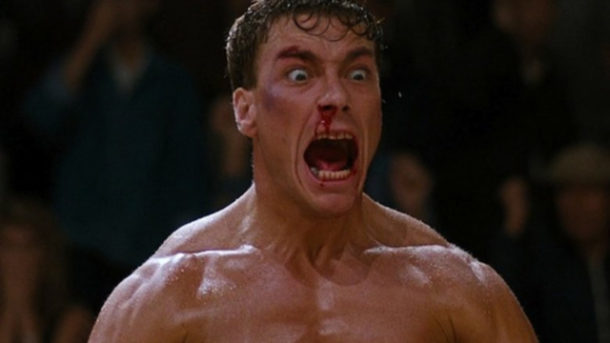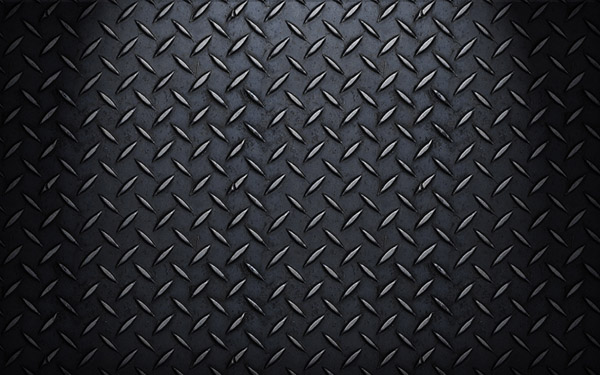Jean-Claude Van Damme Was ‘Coked Out of His Mind’ During ‘Street Fighter,’ Director Says
It was the early 1990s and every teenager in the world knew about Street Fighter II. Originally released in the arcades and then on the SNES and Mega Drive consoles, the game a cast of weird, semi-magical combatants with names like Ryu, Chun-Li and Guile battling it out for victory in the World Fighting Championship. It was colourful, competitive and ridiculous. It sold 15 million copies.
Realising the cinematic potential of the game’s giant brand, publisher Capcom soon dispatched a retinue of execs to Hollywood. Experienced producer Ed Pressman saw the potential immediately and he knew who to call: Steven De Souza, writer of Die Hard and Commando, and before those, TV hits such as The Hardy Boys, The Six Million Dollar Man and Knight Rider. Steven had impeccable action-entertainment experience, and was even working on an animated series, Cadillacs and Dinosaurs, for which Capcom had produced a tie-in video game. There was, in Hollywood business parlance, synergy.
Street Fighter: The Movie was not a critical success. On its release in December 1994 – a year after the calamitous Super Mario Bros film – it was derided as another ludicrous cash-in tossed at impressionable kids by cynical Hollywood execs. Reviewers railed against the cardboard characters and fans of the game derided the lacklustre, frenziedly edited fight scenes. However, unlike Super Mario Bros, Street Fighter: The Movie made money (lots of it), and the story of its troubled development is not one of incompetence but of tragic circumstances and drug-fuelled narcissism. And it began, as these things often do, with a frantic meeting.
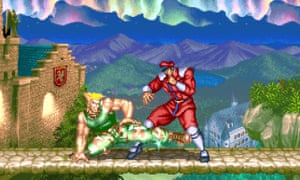
“Ed and another producer came to me and said: ‘Capcom is going around – can you come up with a take for a movie? They’ll be here the day after tomorrow,’” recalls De Souza of the pitch. “I said: ‘Yeah, I’m very familiar with it – my son had just put his first year of college into that machine.’ I said I’d come up with a treatment, but I wanted to direct.”
De Souza wasn’t interested in making a tournament movie – he wanted something more like a James Bond adventure, with a proper plot and exotic locations. “Unbeknownst to me, Capcom was thinking in this direction,” he says. “When they came to the meeting they brought some artwork to help me, and one image had Bison as the most wanted criminal in the world, in a James Bond-style underground lair. I could see they were energised during our meeting, and within a week they said: ‘You guys are doing it.’”
De Souza started working on his script, imagining Bison as the corrupt dictator of a fictional south-east Asian state, looking to take over the world with an army of genetically modified super soldiers. Guile would be the special forces hero, teaming up with street fighters Ken and Ryu to foil the dastardly plan.
Meanwhile, the producers set up the logistics. There was a modest $30m budget, with a 10-week shoot – six weeks on location in Thailand, followed by four in Australia at the new Warner Bros studio on the Gold Coast. De Souza’s plan was to funnel a portion of the budget into training the actors in martial arts before filming began, calling in the famed fight choreographer, Benny “The Jet” Urquidez to help out.
But then things started to go awry. Capcom decided it needed a big star for Guile and the producers went for Jean-Claude Van Damme – who, after the success of Timecop, was the biggest action movie actor in the world, with a price tag to match. To add some gravitas on the baddie side, the hugely respected character actor Raul Julia was approached to play Bison. He accepted, thanks in part to his kids, who were huge fans of the game. But like Van Damme, he wasn’t coming cheap.
“Now we had a couple of big stars in the cast but less money to make the movie,” says De Souza. “It meant all the other actors had to be really new names. That was fine, but we no longer had the money to hire them in advance for fight training. I said: ‘OK, we’ll film all the ‘people talking in rooms’ scenes early on, and while we’re doing those, the other characters will be off training.’ I thought, we’ll be filming for 10 weeks, so everyone will have three to six weeks of choreography on these fights. That was the plan.”
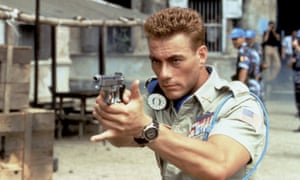
It wasn’t the only challenge. De Souza had managed to convince Capcom to let him focus on just seven or eight characters from the Street Fighter roster, rather than all 19. “In the 100-odd minutes of the movie, there wasn’t a lot of screen time to go around – do the math,” he says. “Furthermore, the audience can barely keep track of seven characters, which is why it’s always been the magic number through history: seven sins, seven wonders, hell, Seven Samurai.
“[But] every time I turned in a draft they kept pressing me to add just more character. I would slide somebody in with a couple of lines. Then they’d say: ‘Can’t so-and-so have another scene, he’s very popular in Japan? And by the way what about this character?’”
Capcom was also attempting to meddle in casting – a situation that came to a head with Ryu. De Souza had already cast young Chinese-American actor Byron Mann in the vital role, but Capcom wanted Japanese actor, Kenya Sawada, who barely spoke English. In the end, De Souza reached a bizarre compromise: Sawada was given a cameo as an entirely new character, Captain Sawada, and Mann was Ryu. “I actually met [Sawada] a couple of times while I was going for casting,” recalls Mann. “He gave me some real dagger looks.”
Finally it seemed all the pieces were in place, but a tragic situation was soon to emerge.
One fight in Bangkok
Unknown to anyone on the production, Raul Julia was extremely unwell. Suffering from stomach cancer and undergoing gruelling treatment, he arrived in Bangkok a shadow of his former self. “I got a phone call from our costume consultant,” recalls De Souza. “She’d gone ahead a day before us to meet Raul and she said: ‘We have a problem. He looks ghastly; he’s like a skeleton.’ We thought: ‘Oh god, what are we going to do? We can’t put him on camera.’ We decided to push all of Raul’s scenes to the end of the movie, so he could gain weight and we’d move other things up front. I was putting people on the camera who’d had virtually no fight practice.”
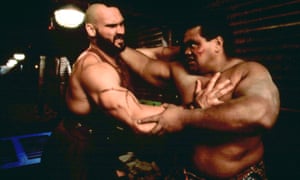
Mann, who’d never starred in a movie before, recalls the ensuing difficulties. “We had our trainer, Benny, but he didn’t know what video game fighting actually was – it was all new to him,” he says. “We only found out midway through the shoot that different characters have different styles. Somebody said: ‘Wait a minute, why is everyone fighting in the same way?’”
There’s a scene where Ryu was to engage in a deadly sword fight with Vega (played by Jay Tavare), and Mann was supposed to have been well-drilled in fighting techniques – but the lessons kept being put off. “Then one day I was having lunch, and an assistant director came over to me and said: ‘Hey, are you ready for your knife fight?’ I said: ‘What are you talking about? I don’t know anything about it.’ I went to one of the Thai extras, a stunt guy, and asked him if he could help. On the spot, he taught me what he knew – and that’s what you see in the movie. And it was a bladed sword, it wasn’t plastic. I could have injured myself and others.”
At the same time, Bangkok was throwing up some of its own challenges. “There was extreme heat, extreme humidity. We were supposed to be looking buff, but we were all losing weight,” says Mann. “If you watch the movie, we all look a lot bigger in the scenes shot in Australia. The weather was fine, the food was nice – we had all recovered.”
There were unique logistical challenges in Thailand, too. “There was talk of a possible coup, so the military closed all the roads down,” remembers Keith Heygate, the first assistant director on the second unit. “We needed to get the cast, the crew and all this equipment to different locations, so we had to travel by high-speed boats down the khlongs [canals] at 1am in the morning. This went on for 10 days, and these boats kicked up a lot of water, so, by the time we got to the location, the cast and crew were all sodden. Van Damme hated that.”
Better still, some of the big special effects were running away from them. “There was a scene where we blew up a temple,” says Heygate. “The art department built it,” he hastens to add. “The effects were only supposed to blow a quarter of it up but it got a bit out of hand. We had Jean-Claude, Kylie [Minogue, who played Cammy] and a bunch of other actors right outside it as it blew – and the whole thing went up. There was $240,000 of scaffolding and it just melted. But the sequence looked great.”
Even the interior shots were beset with troubles. Local production staff had sourced an old coast-guard building as a sound stage (it’s the building the Allied Nations take over as their HQ in the film), but the hangar had a tin roof – and it was the rainy season. “The noise was staggering,” says De Souza. “And even when the rain stopped, the walls were riddled with holes. It was like a John Woo gunfight had taken place in there – the sunlight would pour in and you couldn’t film anything. Also, I don’t know if it was the rainy season or defective equipment, but we’d be filming and the lights would just go out.
“After 10 days in Bangkok we were six days behind schedule – it was tortuous. The producers said: ‘You’re running behind!’ So I did an old John Ford trick: I just opened the script and ripped a page out and said, there, we’re back on track.”
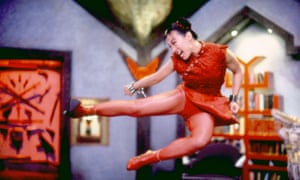
With scenes being shot in a bewildering sequence or cut entirely, cast members struggled to make sense of their roles. “I didn’t know the character; I didn’t know the video game; I didn’t know what the hell I was doing,” says the veteran Indian actor Roshan Seth, who played Dhalsim.
“I was supposed to be a mad scientist. I thought: What sort of science am I supposed to be doing and what am I mad about?’ There’s a scene where my character has to pull out his hair in anger – they spent all day fitting me with a skull cap so I could literally pull my hair out. I just stopped thinking – they just told me what to do and I followed instructions.”
The Australian actor Robert Mammone was employed to play spec-ops soldier Carlos Blanka, who is captured by Bison and transformed into the green-skinned Blanka we know from the games. He only discovered that a body double was to play the post-transformation scenes when he met him at a cast party before shooting. Mammone still had to do close-ups, though, which meant spending three hours a day in makeup, getting Blanka’s green skin and wild orange hair. Then he’d have to sit around for hours. “I used to take a book with me on to set all the time. I was reading On The Road and I used to discuss it with Steven. In that scene where I’m strapped into the cubical, in between takes, I was made up as Blanka reading Jack Kerouac.”
Amid the chaos and uncertainty, the actors did what they could to cope, hanging out in Bangkok bars at night and the gym during the day. “Between me, Vega, Ken [played by Damian Chapa] and Zangief [Andrew Bryniarski], there was a definitely a lot of machismo going on,” says Mann. “This wasn’t Sleepless in Seattle; it was who has the biggest biceps today.”
Ming-Na Wen, who played Chun-Li, and underwent intense weight training in the lead up to the film, remembers it a little differently. “They were all big wussies,” she says, laughing. “I won’t name names, but I got into one of those brother-sister banter relationships with one of the other actors. I remember one day, I punched him so hard he cried. We were just goofing around!”
Van Damme it all
In a cast full of young newcomers and civilised character actors, Jean-Claude Van Damme stood out as the archetypal movie star, with an ego to match. As he later admitted, he also came into Street Fighter with a major cocaine habit. At one stage in the 1990s, he was hoovering 10g a day; and $10,000 a week.
“I couldn’t talk about it at the time, but I can now: Jean-Claude was coked out of his mind,” says de Souza. “The studio had hired a wrangler to take care of him, but unfortunately the wrangler himself was a bad influence. Jean-Claude was calling in sick so much I had to keep looking through the script to find something else to film; I couldn’t just sit around for hours waiting for him. On two occasions, the producers allowed him to go to Hong Kong, and both occasions he came back late – on Mondays he just wasn’t there at all.”

Heygate has similar memories. “He was an interesting man, but he was extremely hard to work with – there are a lot of stories I can’t share,” he says. “There was one time he was in the trailer and he was quite pissed. My assistant couldn’t get him out, I couldn’t get him out, so I had to call the producer, Chad Rosen, to get him out. Then he came out with a bottle of a champagne. I told him it was against health and safety to have alcohol on set. From that point on, he hated me.”
The rest of the actors recall a frustrating and bemusing experience. “He had the presidential suite at the hotel, with a gym put into his room,” recalls Seth. “Sometimes he wouldn’t turn up on set – the message would come through from him saying: ‘I have to pump up my muscles!’ and that was that.”
Mammone managed to strike up a better relationship with him. “Van Damme certainly grandstanded around the set – he let everyone know who the star was,” he recalls. “He’d stay in the trailer until he was ready to come out; he’d take up so much time for a shot; scenes that should have only taken an hour could take half a day. But for some reason, perhaps because we played best mates in the movie, he was fine with me. We went to dinner, we hung out, he gave me my first proper Cuban cigar. One day, we were sitting in the makeup chairs and he said to me: ‘Robert, you have the stink of Tony Curtis.’ I think he meant ‘essence’.”
Van Damme has also since confessed to having an affair with co-star Minogue during the filming. Minogue was brought in late when De Souza found he needed an actor to play Cammy, and saw a photo of her on the cover of People magazine while on his flight over to Australia. Whatever the cast and crew thought of Van Damme, they all loved her. “She was a true professional – she was absolutely wonderful,” says Heygate. “During the filming, she actually hired out a club for the cast and crew to have a good time, because it was a tough shoot. She bought all the drinks and everything.” Wen concurs. “We bonded on set because we were the only two girls. We went out for dinner a lot. She is lovely, such a sweet human bein.”
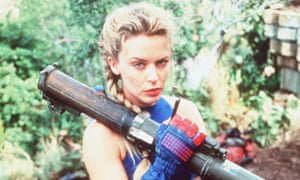
Julia also drew the admiration and respect of his fellow actors. Terribly ill throughout the production, and accompanied by his wife and children – who may have known their time with him was limited – he gave everything he had to the Bison role.
“It was a joy to be on the same set as him,” says Mammone. “He wasn’t a movie star, he wasn’t a celebrity – he was an actor in the true sense of the word. The focus and concentration he maintained are things that I’ve carried with me for the rest of my career. When he stepped on set, he was that character.” Seth, too, has fond memories. “He used to sneak out at night like a tomcat,” he says. “He would go off gambling with a big Havana cigar clenched between his teeth. I thought that was terrifically romantic.”
Re-shoots, re-edits, reviews
When filming ended in Australia, the challenge wasn’t over. Several pages of the script hadn’t been shot, and when De Souza looked at some of the climactic fight scenes, he realised the choreography was patchy and boring. So he re-called several of the stars, set up an identical bunch of sets at a studio in Vancouver and did days of re-shoots.
All along, De Souza had been aiming for a PG-13 certificate, holding back on graphic violence in order to get those pre-teen Street Fighter fans into cinemas. “I was confident I’d shot a PG-13 film,” he says. “I had worked in TV for years and the shows I did – like Knight Rider – were considered family entertainment. I knew my way around ratings. But a week before we turned the movie in to the Motion Picture Association of America, there had been a school shooting. They gave it an R rating.
“I said: ‘Listen, we’ll just have to cut back.’ So we took out any places where you saw blood, we submitted it again and it was still an R. Now we started to take out some of the shots where impact was shown. I’m cutting away, cutting it back, back, back, and finally we hand it in – they give it a G rating. That would have been the kiss of death – no teenager wants to see a G movie! So I had Jean-Claude come in for one day and I added a line: ‘Four years of ROTC for this shit.’ That got us back up to PG-13.”
When the film premiered on 23 December 1994, the reviews were savage. The New York Times called it “a dreary, overstuffed hodgepodge of poorly edited martial arts sequences and often unintelligible dialogue”, which summed up the critical consensus.
With hindsight, however, Street Fighter: The Movie is a charmingly camp and self-consciously silly action flick, offering a fast-cut, colourful and unmistakably early-90s take on video game culture. Much of that “unintelligible dialogue” has slipped into internet legend. There’s Chun-Li’s escape from AN custody (“what a screw up”, “what a woman”); and Van Damme’s confrontation with Simon Callow’s ambassador (“Colonel, have you lost your mind?”, “No, you’ve lost your balls”). And, of course, every single Raul Julia scene, from the moment he complains: “Why do they call me mad? All I want to do is create the perfect genetic soldier,” to the scene where Chun-Li confronts him about murdering her father, and he responds: “For you, the day Bison graced your village was the most important of your life. But for me … it was Tuesday”.
“I’ll be perfectly honest, I was a little concerned when I saw the film,” says Wen. “I came from Carnegie Mellon university, I studied seriously as an actor, I did Shakespeare in the theatre. I can look back with fond memories now, but there were some cringe-worthy moments. At the time I was shooting ER and I remember saying to George Clooney: ‘Oh gosh, I think my career might be over.’ He said: ‘Oh honey, it takes a lot to kill a career – I should know.’”
And the careers of the Street Fighter graduates did come out intact. Van Damme recovered from his drug problems and made the staggering postmodern confessional JCVD; Minogue is a superstar; Mann has just starred in Skyscraperwith The Rock, and Wen has joined the Marvel universe via Agents of SHIELD. For his part, De Souza, who is cheerful, funny and generous while discussing the movie, is un-self-consciously proud of it. “Jean Claude made two films that earned $100m: Timecop and this one,” he says. “It was extremely profitable for the studio – it cost $33m and made $105m, so it was good for everybody. People say it’s so dimwitted it’s funny, but we knew it was funny.
“How can you see that movie and think it’s funny by accident?”

